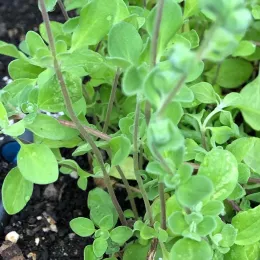Marjoram

Marjoram is grown for its aromatic leaves, which can be used fresh or dried. Closely related to oregano, they are sometimes used interchangeably in recipes. In general, marjoram has a sweeter, more floral flavor than oregano. Enjoy marjoram in soups, egg dishes, beef and chicken dishes, sausages, and cheese dishes. Flower heads are often used in craft work.
How to grow
- Type: Perennial, woody
- Light: Full sun. Variegated leaf varieties prefer afternoon shade.
- Soil: Well drained
- Water: Moderate
- Mature Size: 1–2' high, 6–8" wide. Space plants 12–18" apart
When to plant/propagate
Marjoram is freeze-sensitive, so in cold winter microclimates grow as an annual or in a container.
- From seed: Direct seed after the last frost date in spring, or sow seeds indoors 8–10 weeks prior to the last frost date
- Transplants: Plant seedlings when danger of frost is past
- Cuttings & divisions: Propagate from cuttings prior to bloom. Divisions can be done year round
Harvesting
- For best leaf flavor, do not allow plant to flower
- Harvest both the tender leaves (to be added at the end of cooking) and hardier leaves with whole stems (typically added at the beginning of the cooking process, then removed)
- For the most tender leaves, harvest frequently to encourage new growth and prevent flowers from developing. Pinch off any flowers that do develop.
- Dry the leaves for winter use. Shelf life is approximately one year.
- Many beneficial insects appreciate marjoram flowers, so consider allowing some plants to flower
Pruning
- Trim during the growing season to keep plants compact and the leaves tender. Marjoram can become woody if not kept compact.
- Soft stems and leaves may be renewed in winter or very early spring by cutting woody stems near their base, just above a low set of leaves
Indoors
Marjoram can be grown as an indoor plant with 5–6 hours of bright light from a sunny window, or 12–16 hours of supplemental light provided by cool white fluorescent or LED lamps
Common pests & diseases
More information
- Oregano & Marjoram, UCCE Master Gardeners of Sonoma County
- Growing Herbs for the Home Gardener, North Carolina State University Cooperative Extension Service
Recommended Varieties for Santa Clara County
There are no specific recommendations for marjoram varieties.
